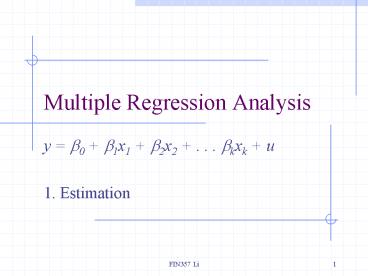Multiple Regression Analysis - PowerPoint PPT Presentation
1 / 12
Title:
Multiple Regression Analysis
Description:
b0 is still the intercept. b1 to bk all called slope parameters ... Our test will still be valid, but less powerful (meaning less likely to detect ... – PowerPoint PPT presentation
Number of Views:13
Avg rating:3.0/5.0
Title: Multiple Regression Analysis
1
Multiple Regression Analysis
- y b0 b1x1 b2x2 . . . bkxk u
- 1. Estimation
2
Similar to with Simple Regression
- b0 is still the intercept
- b1 to bk all called slope parameters
- u is still the error term (or disturbance)
- Still assume that E(ux1,x2, ,xk) 0
- Still minimizing the sum of squared residuals
3
Interpreting the coefficient
4
Goodness-of-Fit
5
Goodness-of-Fit (continued)
- Can compute the fraction of the total sum of
squares (SST) that is explained by the model. - R2 SSE/SST 1 SSR/SST
6
Too Many or Too Few Variables
- What happens if we include variables in our
specification that dont belong? - OLS estimators remain unbiased. Our test will
still be valid, but less powerful (meaning less
likely to detect significant relationship) - What if we exclude a variable from our
specification that does belong? - OLS estimators will usually be biased
7
Omitted Variable Bias
8
Omitted Variable Bias Summary
- Two cases where there is no bias using a simple
regression - b2 0, that is x2 doesnt really belong in model
- x1 and x2 are uncorrelated in the sample.
9
- The following 3 slides are some technical notes.
- You could ignore them if find them boring.
10
Assumptions in OLS
- Population model is linear in parameters y
b0 b1x1 b2x2 bkxk u - We use a random sample of size n, (xi1, xi2,,
xik, yi) i1, 2, , n, from the population - E(ux1, x2, xk) 0 .
- None of the xs is constant, and there are no
exact linear relationships among xs
11
Further assumption
- Assume Var(ux1, x2,, xk) s2
(Homoskedasticity) - Theses 5 assumptions are known as the
Gauss-Markov assumptions
12
The Gauss-Markov Theorem
- Given our 5 Gauss-Markov Assumptions it can be
shown that OLS is BLUE, or Best Linear Unbiased
Estimator. - Thus, if the assumptions hold, use OLS































